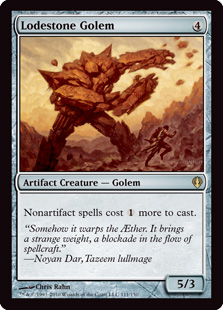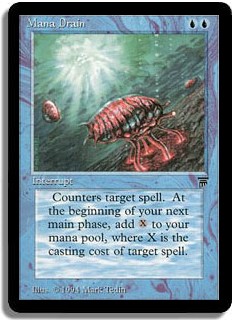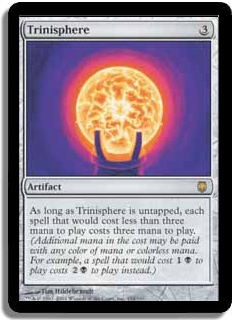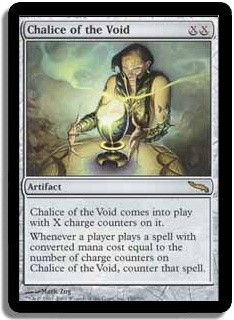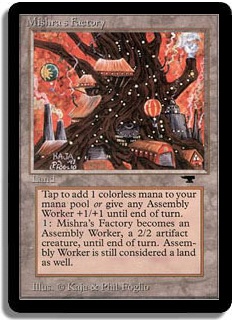Welcome back! It’s been a while since I’ve written about Vintage, so I’m pretty excited to be back and battling some really powerful decks against one another. In this week’s article, I’m going to detail a match featuring Forgemaster MUD against the new U/W Landstill control deck. Both decks are formidable in different ways and are likely to be popular choices for upcoming Vintage events. Thus, testing out the matchup seems to have a lot of practical implications.
Here are the lists my opponent and I used:
Creatures (8)
Planeswalkers (3)
Lands (17)
Spells (32)
- 1 Brainstorm
- 3 Mana Drain
- 1 Plains
- 4 Force of Will
- 2 Swords to Plowshares
- 3 Island
- 1 Time Walk
- 1 Ancestral Recall
- 4 Standstill
- 1 Black Lotus
- 1 Mox Pearl
- 1 Mox Ruby
- 1 Mox Sapphire
- 2 Mindbreak Trap
- 1 Batterskull
- 3 Mental Misstep
- 2 Flusterstorm
Sideboard

Creatures (17)
- 1 Sundering Titan
- 1 Duplicant
- 4 Lodestone Golem
- 1 Steel Hellkite
- 4 Kuldotha Forgemaster
- 3 Phyrexian Revoker
- 3 Phyrexian Metamorph
Lands (19)
Spells (24)

I’ve had quite a few requests to play from the Mishra’s Workshop side of things, so this time I will be piloting the MUD deck while my opponent plays U/W Landstill.
Without any further delay, let’s get to the games!
Game 1
I win the die roll with MUD and elect to go first. Obviously, being on the play is a huge advantage with a Workshop deck, but if any deck has the tools to battle back, I believe that the Landstill deck might be able to make a match of it!
Turn 1
I fan out the following opening hand and snap keep it.
My turn 1 play here should be pretty clear: lead with the Ancient Tomb and cast Sphere of Resistance. I make precisely this play and pass the turn, taking two damage in the process. We don’t want to lead out on a Mishra’s Workshop here because there’s a good chance that he’ll Wasteland us if we do. Although it saves us two life, ultimately hit points aren’t the most important thing at stake at this juncture of the game. It’s important that I get one big boost out of the three mana.
Our follow up play is likely to be to ramp Workshop into Lodestone Golem next turn through our Sphere of Resistance.
After drawing a card for his turn, my opponent plays out a Flooded Strand and passes the turn.
Turn 2
For our turn we draw Mana Crypt, which is interesting because it gives us the option to play our Kuldotha Forgemaster if we want. However, the Lodestone is actually just better here as it continues to disrupt my opponent’s mana and provides me with a clock.
I play the Workshop and use it to cast Mana Crypt and then the Lodestone Golem (taking two from Ancient Tomb in the process). While I like to be savvy about saving Mana Crypt sometimes in order to not take damage, it’s important to play it here because there’s the possibility that he has a Force of Will and could turn around and Wasteland our Workshop. Even if he makes this play (which is quite good), we can still play our Forgemaster during our next turn to try to keep the pressure up.
The Lodestone Golem resolves, and I pass the turn.
Â
Â
“By the time you get out from under this, you’ll be dead.”
After drawing a card for the turn, my opponent plays a Mishra’s Factory and passes the turn. Presumably, he’s hoping to be able to trade his Factory next turn with the Lodestone or possibly just hold it off while he tries to get lands into play to cast spells.
Turn 3
On my upkeep I take three from the Mana Crypt, dropping me to thirteen life, and draw an Ancient Tomb, which doesn’t do anything for me just yet.
I attack with the Lodestone Golem, which drops my opponent down to fifteen life. In my second main phase I play my Strip Mine (which elicits a groan from my opponent) and then play a Kuldotha Forgemaster, tapping my Ancient Tomb for the third time and dropping me to eleven.
I give my opponent the brief glimmer of hope that I’m not going to Strip Mine him right away before actually activating Strip Mine to kill his Mishra’s Workshop. “Oh, you saw the play. I guess I don’t get to cast any spells this gameâ⒬¦”
It’s pretty obvious that the play is to Strip Mine him now before he gets to play a third land (which could potentially cast Swords to Plowshares during his main phase).
On my opponent’s turn, he draws and plays another Mishra’s Factory and passes the turn.
Turn 4
On my upkeep my Mana Crypt deals three damage to me, dropping me down to eight life, which is irrelevant because I have the Forgemaster to get rid of the card if I need to. I draw another Lodestone Golem for the turn.
I play my second Ancient Tomb and tap all three of my lands and Mana Crypt to add nine colorless mana to my mana pool (taking four more damage in the process, which drops me down to four life) in order to cast Lodestone Golem and Tangle Wire.
I attack with the Lodestone Golem, which drops my opponent to ten life, and pass the turn.
During my opponent’s turn after he taps his lands to Tangle Wire, I go to use my Kuldotha Forgemaster and my opponent concedes.
MUD wins.
For the record, the opening hand that my opponent kept (which didn’t actually get to play a spell the entire game) was:Ã’Â Flooded Strand, Strip Mine, Island, Swords to Plowshares, Mana Drain, Mindbreak Trap, Stoneforge Mystic. It’s not actually a terrible hand. Unfortunately, this was one of those Workshop games where if the opponent doesn’t have Force of Will, they don’t get to cast a spell the entire game.
Sideboarding
MUD
-1 Kuldotha Forgemaster
-1 Duplicant
-1 Steel Hellkite
+2 Crucible of Worlds
+1 Ghost Quarter
U/W Landstill
-3 Mental Misstep
-2 Flusterstorm
-2 Aven Mindcensor
+2 Disenchant
+2 Serenity
+1 Swords to Plowshares
+2 Kataki, War’s Wage
Game 2
My opening hand is:
I keep it.
Turn 1
My opponent plays Mox Sapphire and Island and passes the turn.
I draw Sphere of Resistance for my turn. I feel as though I’m walking into Mana Drain here, and even worse, probably a Wasteland. If I run out my Trinisphere here and he kills my Workshop, I’m probably going to die. I decide to simply play a Wasteland and pass the turn.
Â
Â
“The thing about permission is that you CAN play around it.”
Turn 2
My opponent draws for the turn, plays a Mishra’s Factory, and passes the turn.
For my draw I find Mox Ruby, which is exactly what I wanted to draw.
I play my second Wasteland and tap all three lands to play Trinisphere. My opponent casts Mana Drain on my Trinisphere, which I assumed that he had, and then I pass the turn back to him.
Â
Â
“Baiting with Trinisphere is pretty filthy. Counter it or don’tâ⒬”either way, you’re screwed.”
Turn 3
My opponent draws, casts Wasteland, and passes the turn.
I draw Phyrexian Revoker for my turn. I play my Mishra’s Workshop and cast Tangle Wire. My opponent taps out to cast Mindbreak Trap on my Tangle Wire.I now have two options. I can Wasteland his Wasteland while it’s tapped, or I can cast a second Tangle Wire. I opt to Wasteland his Wasteland in order to protect my Workshop.
Turn 4
My opponent draws and plays a Flooded Strand. He then activates Mishra’s Factory with his Mox Sapphire and attacks me for two. I’m now at eighteen, and he’s at 20.
On my turn I draw another Mishra’s Workshop, which is a little bit awkward since we just went to such great lengths to protect the one we had. Fortunately, the card is insane and is going to let us play a bunch of stuff this turn!
First, I play Tangle Wire, which resolves.
Second, I play Phyrexian Revoker, which also resolves. I name Mox Sapphire to shut down his mana source.
I then play Sphere of Resistance and pass the turn. On my end step, my opponent fetches out a Plains.
Turn 5
On his upkeep, he taps down his cards and draws for the turn. He has no plays and passes back to me.
On my turn, I tap down Tangle Wire, Sphere of Resistance, and Mox Ruby to the Wire and draw a Kuldotha Forgemaster.
Since my opponent is pretty badly locked under the Wire, I have to decide between two plays: cast the Forgemaster or the Chalice of the Void for two. I decide that the play is to make Chalice of the Void first since it will protect the Forgemaster later from a potential Disenchant. And besides, the one thing I want to make sure I play this game is a Chalice of the Void for two, as it protects me from Kataki and Serenity.
The Chalice resolves, and I send in my Revoker for two damage. Lastly, I use my Wasteland to destroy his Mishra’s Factory so that he’ll have to tap all of his permanents to the Tangle Wire during his upkeep.
Turn 6
My opponent once again is forced to tap all of his permanents to the Tangle Wire, and once again he makes no more plays and passes the turn.
I tap my Chalice of the Void and Sphere of Resistance to my Tangle Wire during my upkeep and draw a City of Traitors for my draw step. I cast my Kuldotha Forgemaster, which resolves, and then I attack my opponent for two with the Phyrexian Revoker, which knocks his life total down to sixteen. Then I pass the turn.
Turn 7
My opponent taps his Plains and his Island during his upkeep with the Tangle Wire trigger on the stack to play Swords to Plowshares on my Forgemaster.
He then draws, plays a Tundra, casts Mox Pearl, and passes the turn.
On my turn I draw a Mishra’s Factory, which I play, and attack my opponent down to fourteen. I then pass the turn.
Turn 8
My opponent taps down his useless Mox Sapphire, draws a card, and then passes the turn back to me.
(Just in case you’re wondering why this game appears to be so boring and nothing seems to be happening, I ask my opponent a question: “Is Chalice of the Void limiting your options?” He nods yes.)
Â
Â
“I bet you WISH you could cast those spells in your hand that WOULD win you the game.”
I draw Black Lotus, but there’s no reason to play it just now, so I don’t. I activate my Factory and attack my opponent for four down to twelve.
Turn 9
My opponent draws and casts a Black Lotus and passes the turn.
I draw another Mishra’s Factory and play it. Then I activate my other Factory and attack with my guys. The newly played Factory pumps the attacker and my opponent takes five damage, dropping him down to seven life.
Turn 10
My opponent draws and plays a Flooded Strand and passes the turn.
I draw a Phyrexian Metamorph.
I finally play my City of Traitors so that I can animate both of my Mishra’s Factory and send my team into the red zone, which drops his life total to one. I figure that my opponent’s only out is to draw a Batterskull, so I cast the Metamorph naming Mishra’s Factory. He shows me Force of Will and Standstill (which he can’t cast because he’s at one life), and if he sacrifices his Black Lotus to cast the Force of Will, he doesn’t have five mana to play a Batterskull.
Turn 11
My opponent draws and reveals his hand of Force of Will, Standstill, Stoneforge Mystic, and Serenity and concedes defeat.
MUD wins 2-0.
My opponent’s keep game 2 was Force of Will, Mana Drain, Mindbreak Trap, Serenity, Mox Sapphire, Island, Flooded Strand, which appears to be a very reasonable keep.
Thoughts on the Matchup
MUD had a pretty overall good matchup against Landstill. The game where I was on the play with a good hand, I absolutely crushed him. The MUD nut draw is unbeatable for blue decks that don’t have Force of Will on the draw.
The game where I was on the draw with a pretty slow hand, I was able to grind out a very good U/W starting hand and lock him down with Tangle Wire and Chalice of the Void for two.
We played a few more games, and it appeared to me that the U/W Landstill deck really only won when certain conditions were met. Firstly, it needed to not get locked out right away (which is pretty obvious). In about 35% of the total games we played (many of the games where MUD was on the play), U/W never got to play a spell and died. Of the remaining 65% of our games, they were grinding battles where U/W won about two-thirds of them, mostly on the back of Kataki and Serenity.
Â
Â
“Big game against MUD if you draw them.”
Before sideboard MUD felt heavily favored, and after sideboard I’d say that MUD felt slightly ahead.
Here’s my breakdown:
In game 1 before sideboarding, if MUD was on the play it was almost impossible to lose. If U/W was on the play, it seemed that MUD was still pretty significantly advantaged.
After sideboarding, being on the play still put MUD way ahead, while U/W was a little bit advantaged on the play.
Overall, this matchup tends to favor MUD by a quite a bit.
I don’t usually play Mishra’s Workshop decks, and normally when I playtest I like to be the blue deck rather than the brown deck. However, actually getting to play from the side of the Mishra’s Workshop deck, I was surprised at how much play I actually had and how much my choices impacted the game. I think that game 2 is a really good example of how making good decisions can really break the back of the blue deck over the course of a long game.
Also, I was kind of taken by how powerful the MUD deck was. Every fourth or fifth game we played, my opponent didn’t get to cast a single spell.
The card that really impressed me as I played more and more games with MUD was Mishra’s Factory. It really gave the deck a lot of closing power and was fantastic against Jace, the Mind Sculptor. There was one game where I beat a Serenity by pounding face with three Factory. Most lists have four Factory, but after playing a bunch with the card I wouldn’t even consider playing less than the max.
Â
Â
“These Assembly Workers do a lot of work in the MUD deck!”
It occurs to me that perhaps the reason that MUD has been putting up such solid results is that it’s simply really, really powerful and super consistent. It’ll be interesting to see if Burning Wish / Oath of Druids is able to take MUD off the pedestal as the best performing deck in Vintage.
Perhaps if Burning Wish starts putting up some results, I’ll have reason to battle that deck against MUD in the future.
Thanks for reading!
Cheers,
Brian DeMars
Â

